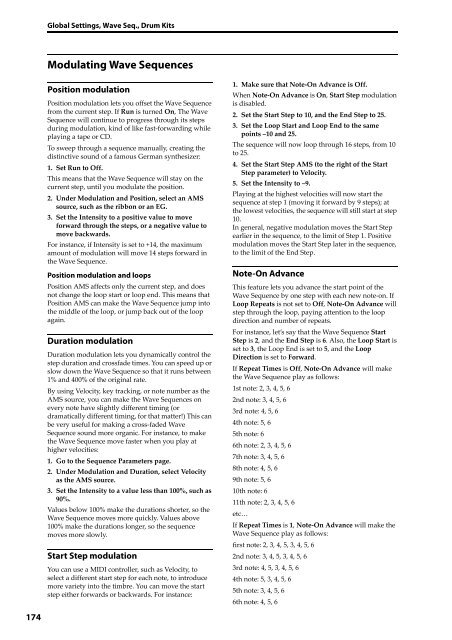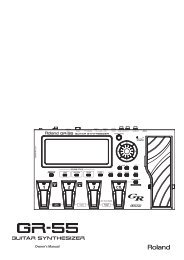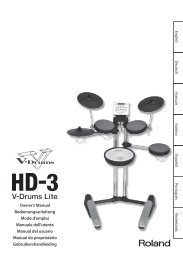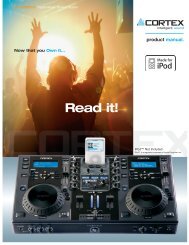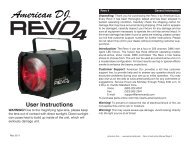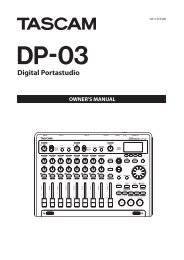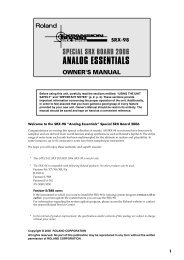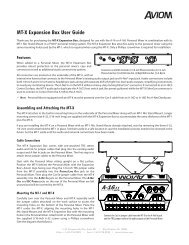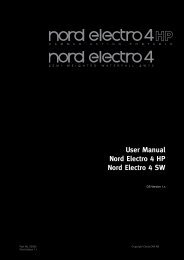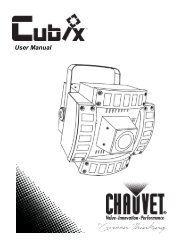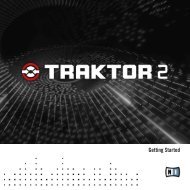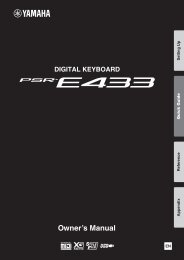KRONOS/KRONOS X Operation Guide - Korg
KRONOS/KRONOS X Operation Guide - Korg
KRONOS/KRONOS X Operation Guide - Korg
Create successful ePaper yourself
Turn your PDF publications into a flip-book with our unique Google optimized e-Paper software.
Global Settings, Wave Seq., Drum Kits<br />
Modulating Wave Sequences<br />
Position modulation<br />
Position modulation lets you offset the Wave Sequence<br />
from the current step. If Run is turned On, The Wave<br />
Sequence will continue to progress through its steps<br />
during modulation, kind of like fast‐forwarding while<br />
playing a tape or CD.<br />
To sweep through a sequence manually, creating the<br />
distinctive sound of a famous German synthesizer:<br />
1. Set Run to Off.<br />
This means that the Wave Sequence will stay on the<br />
current step, until you modulate the position.<br />
2. Under Modulation and Position, select an AMS<br />
source, such as the ribbon or an EG.<br />
3. Set the Intensity to a positive value to move<br />
forward through the steps, or a negative value to<br />
move backwards.<br />
For instance, if Intensity is set to +14, the maximum<br />
amount of modulation will move 14 steps forward in<br />
the Wave Sequence.<br />
Position modulation and loops<br />
Position AMS affects only the current step, and does<br />
not change the loop start or loop end. This means that<br />
Position AMS can make the Wave Sequence jump into<br />
the middle of the loop, or jump back out of the loop<br />
again.<br />
Duration modulation<br />
Duration modulation lets you dynamically control the<br />
step duration and crossfade times. You can speed up or<br />
slow down the Wave Sequence so that it runs between<br />
1% and 400% of the original rate.<br />
By using Velocity, key tracking, or note number as the<br />
AMS source, you can make the Wave Sequences on<br />
every note have slightly different timing (or<br />
dramatically different timing, for that matter!) This can<br />
be very useful for making a cross‐faded Wave<br />
Sequence sound more organic. For instance, to make<br />
the Wave Sequence move faster when you play at<br />
higher velocities:<br />
1. Go to the Sequence Parameters page.<br />
2. Under Modulation and Duration, select Velocity<br />
as the AMS source.<br />
3. Set the Intensity to a value less than 100%, such as<br />
90%.<br />
Values below 100% make the durations shorter, so the<br />
Wave Sequence moves more quickly. Values above<br />
100% make the durations longer, so the sequence<br />
moves more slowly.<br />
Start Step modulation<br />
You can use a MIDI controller, such as Velocity, to<br />
select a different start step for each note, to introduce<br />
more variety into the timbre. You can move the start<br />
step either forwards or backwards. For instance:<br />
1. Make sure that Note‐On Advance is Off.<br />
When Note‐On Advance is On, Start Step modulation<br />
is disabled.<br />
2. Set the Start Step to 10, and the End Step to 25.<br />
3. Set the Loop Start and Loop End to the same<br />
points –10 and 25.<br />
The sequence will now loop through 16 steps, from 10<br />
to 25.<br />
4. Set the Start Step AMS (to the right of the Start<br />
Step parameter) to Velocity.<br />
5. Set the Intensity to –9.<br />
Playing at the highest velocities will now start the<br />
sequence at step 1 (moving it forward by 9 steps); at<br />
the lowest velocities, the sequence will still start at step<br />
10.<br />
In general, negative modulation moves the Start Step<br />
earlier in the sequence, to the limit of Step 1. Positive<br />
modulation moves the Start Step later in the sequence,<br />
to the limit of the End Step.<br />
Note-On Advance<br />
This feature lets you advance the start point of the<br />
Wave Sequence by one step with each new note‐on. If<br />
Loop Repeats is not set to Off, Note‐On Advance will<br />
step through the loop, paying attention to the loop<br />
direction and number of repeats.<br />
For instance, let’s say that the Wave Sequence Start<br />
Step is 2, and the End Step is 6. Also, the Loop Start is<br />
set to 3, the Loop End is set to 5, and the Loop<br />
Direction is set to Forward.<br />
If Repeat Times is Off, Note‐On Advance will make<br />
the Wave Sequence play as follows:<br />
1st note: 2, 3, 4, 5, 6<br />
2nd note: 3, 4, 5, 6<br />
3rd note: 4, 5, 6<br />
4th note: 5, 6<br />
5th note: 6<br />
6th note: 2, 3, 4, 5, 6<br />
7th note: 3, 4, 5, 6<br />
8th note: 4, 5, 6<br />
9th note: 5, 6<br />
10th note: 6<br />
11th note: 2, 3, 4, 5, 6<br />
etc…<br />
If Repeat Times is 1, Note‐On Advance will make the<br />
Wave Sequence play as follows:<br />
first note: 2, 3, 4, 5, 3, 4, 5, 6<br />
2nd note: 3, 4, 5, 3, 4, 5, 6<br />
3rd note: 4, 5, 3, 4, 5, 6<br />
4th note: 5, 3, 4, 5, 6<br />
5th note: 3, 4, 5, 6<br />
6th note: 4, 5, 6<br />
174


